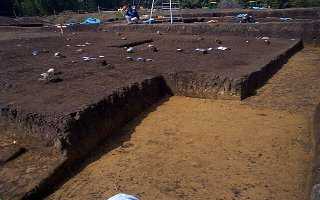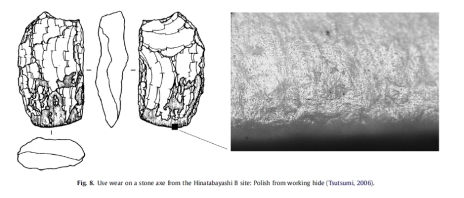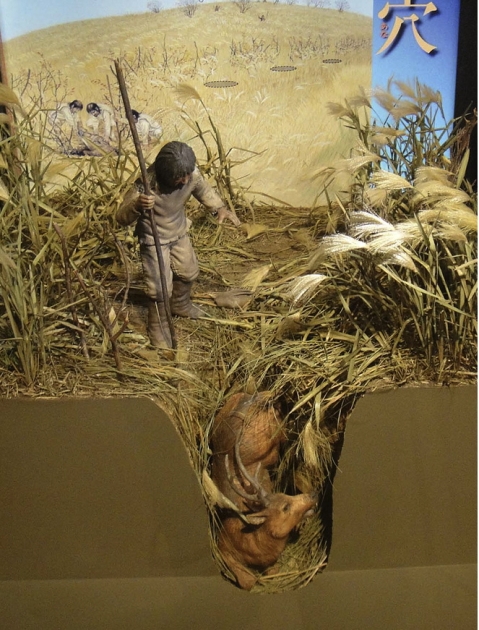A new publication by Takashi TSUTSUMI (2012), published in Quaternary International (unfortunately filed under his first name Takashi), examines edge-ground stone axes which belong to the early Upper Palaeolithic of the Japanese archipelago, their possible uses, and their importance for the question of when the first modern humans arrived in Japan. He especially draws on his work at the Hinatabayashi B site. Edge-ground axes were first discovered in 1949 at the site of Iwajuku. However, their connection to the Palaeolithic wasn’t readily recognized and they were instead attributed to a pre-ceramic Neolithic by Yamanouchi (Yamanouchi and Sato 1962). This was mainly based on a comparison with European polished axes. Only large-scale excavations from the 1970s onwards allowed a more precise dating and their attribution to the Palaeolithic period.
In Europe pottery vessels are markers for Neolithic cultures; so are polished stone axes. While some ground stone axes can be found in the later Mesolithic of Ireland (Woodman 1978) and Wales like these from Nab Head II (David 1989) in Wales no earlier ground stone axes are known in Europe.
In Japan, however, the situation is different. While modern humans (Homo sapiens) only arrived around 40,000 BP on the Japanese archipelago, it wasn’t before long that they began to experiment with lithic technology. Soon the first edge-ground axes (局部磨製石斧(きょくぶませいせきふ) appeared. The earliest ones are from Ishinomoto site 石の本遺跡 in Hirayama, near Kumamoto on Kyushu. Radiocarbon dated charcoal associated with these axes gave dates between 35,000 and 32,000 cal BP (Takashi 2012, 73).

Ishinomoto Iseki – AT boundary http://homepage3.nifty.com/tmizuno/kyuusekki_isekivisit/ishinomoto.html
This innovation rapidly spread throughout Kyushu and Honshu. Although seafaring was practiced at this time the Okinawan islands as well as Hokkaido are interestingly void of edge-ground axes.

Distribution of early Early Upper Palaeolithic (eEUP) sites in the Japanese Archipelago (Tsutsumi 2012, fig. 3)
The basis for dating these edge-ground axes are quite solid with the well-dated Aira-Tn tephra (AT) that covers all of Kyushu, Shikoku, and Honshu. The high precision 14C age for the AT tephra is 25,120 ± 270 BP (Miyairi et al. 2004). The tephra marks the boundary between the Early Upper Palaeolithic (EUP) beneath the tephra band and the Later Upper Palaeolithic (LUP) above the tephra band. All edge-ground axes are from strata below the Aira-Tn tephra. Radiocarbon dates associated with charcoal from several sites confirm a dating to the EUP.
To give you some examples with rough dates (for exact dates see Tsutsumi Takashi 2012, 73 and table 1):
|
Site |
cal. Radiocarbon Dates BC |
| Ishinomoto |
38,500 – 35,800 |
| Fuji-ishi |
36,500 |
| Hinatabayashi B |
35,000 – 32,000 |
| Umenokizawa |
35,000 – 31,000 |
| Mukoda |
34,000 – 33,700 |
Apart from serpentine stone used for edge ground axes, andesite, chalcedony, and obsidian provided the raw material for flake tools. They show very clearly the existence of a wide trading network and even the beginning of expeditions to exploit certain territories. Obsidian, for example, must have been brought in from at least more than 40 km and the Kozu Island Obsidian from even further away, namely about 100 km into the Pacific, reachable only by boat.
To decide upon the usage of these axes Tsutsumi looked at the available use wear data (Sahara 1993, Tsutsumi 2006, Takahashi 2004, Iketani 2004) as well as conducting additional studies on 36 axes from Hinatabayashi B. It is interesting to note that all the chipped axes found at Hinatabayashi B did not show any traces of use wear. Tsutsumi therefore concludes that these are unfinished products. The larger edge-ground axes which showed signs of heavy work, were most probably used for felling trees and modifying wood. Smaller axe heads which showed few evidence of damage on the blades display the characteristic luster that comes from processing hide.
This is well in accordance with vegetation reconstructions for this time period. At Hinatabayashi B for example, pollen records show that Picea (spruce), Abies (firs), and Tsuga (hemlock) prevailed around Lake Nojiri (Kudo & Kumon 2012, 29) and were used as fire wood. Today, this type of vegetation can be found at 1500 – 2500 m asl, but conditions at the EUP were colder and therefore these kinds of forests could be found around Lake Nojiri (650 m asl).
Especially flake tools of type E and F suggest hunting activity; use-wear analyses showed that they were used for cutting meat but also for stabbing as in a thrusting-spear. However, although Naumann’s elephants (Palaeoloxodon naumanni) and giant deer (Sinomegaceros yabei) were present in Honshu, fossils of these large animals are scarce and kill sites of the EUP (40 – 30 ka BP) unknown (but see Anthropology and Archaeology Research Group for Nojiri-ko Excavation (ed.), Study on the Paleolithic Sites around Lake Nojiri (野尻湖周辺の人類遺跡), The memoirs of the Geological Society of Japan (19), 215-249, 1980 and http://www.avis.ne.jp/~nojiriko/nojirikojin.html).
On the other hand some 50 trap pits are known from a wide range of sites dated to the Early Upper Palaeolithic. Hatsunegahara 初音ヶ原 (Ono et al. 2002, 480) from about 27 to 25 ka BP is one of the largest trap sites, featuring 60 pit traps; even older is the site of Ôtsubobata with 12 pits dating to 30 ka BP (Yamamato & Kawaguchi 2009).
These traps were used simultaneously and were carefully laid within the game trail that lead down to the valley.

Distribution of trapping pits (Tanegashima). The white arrows indicate the direction of the game trail.
http://archaeology.jp/sites/2009/02otsubobata.htm
The altogether twelve pit traps in Otsubobata on the island of Tanegashima have been closed by the Tane IV ash layer and thus gave the possibility of quite accurate dating, since the Tane IV ash layer is dated (30.5 ka BP).
Where did these Palaeolithic hunter-gatherers live?
Several larger group campsites (some up to 80 m in diameter) have been studied. They consist mostly of large circular or oval areas with a central open space and huts or tents distributed around it.
This is how it is imagined how such a circular campsite might have looked like; it is an artistic view of the Kambayashi site 上林遺跡 (30-20,700 BP) based on stone artefact distributions. It is estimated to have provided space for 50 to 100 people or about 10 families.

Artistic rendering of the Kambayashi campsite
http://tetsuyuki-fukumoto.art.coocan.jp/
Campsites are usually built on river terraces or slopes overlooking a water source which would have also been their hunting ground.
However, this view has recently been challenged by Takanori SAKASHITA (2010) who studied the site of Tana Mukaihara 田名向原遺跡 (19-23,000 calBP). The results of the re-excavation showed that thermally altered obsidian artifacts are not only concentrated around the hearths, but also in the post holes, suggesting that the so-called post holes indeed functioned as hearths. On the other hand, cooking stones and other material from the two larger central hearths could still have been used as stabilizer for posts as a secondary usage or the ‘post holes’ could indeed have been smaller fire places associated with light tents (which would not have left any traces). A re-examination of other circular campsites would be necessary to decide which interpretation would be more appropriate.
References:
David, A 1989. Some Aspects of the human presence in west Wales during the Mesolithic. In: Bonsall, C (ed.) The Mesolitic in Europe, Edinburgh, 1989, 241-53.
Iketani, K., 2004. Use-wear analysis of the axe-shaped tools from the Ryusuijiura site. Ryusuijiura Site, pp. 162-180, Inbagun City Archaeological Center (in Japanese). Cited by Takashi 2012.
Kudo, Y Kumon, F 2012. Paleolithic cultures of MIS 3 to MIS 1 in relation to climate changes in the central Japanese islands, Quaternary International 248, 22-31. http://dx.doi.org/10.1016/j.quaint.2011.02.016
Miyairi, Y et al. 2004. Improved 14C dating of tephra layer (AT tephra, Japan) using AMS on selected organic fractions, Nuclear Instruments and Methods in Physics Research Section B: Beam Interactions with Materials and Atoms 223-224, 2004, 555-8. http://dx.doi.org/10.1016/j.nimb.2004.04.103
Ono, A, Sato, H, Tsutsumi, T and Kudo, Y 2002. Radiocarbon Dates and Archaeology of the Late Pleistocene in the Japanese Islands, Radiocarbon 44 (2), 477-94. Available here.
Sahara, M 1993. The Cultural History of Axes, Tokyo (in Japanese).
Sakashita, T 2010. Assessing the Reality of a Palaeolithic “Dwelling Structure” in the Japanese Archipelago: The Structure of the Tana-Mukaihara Site, Asian Perspectives 49 (2), 318-31.
Takahashi, S., 2004. Use-wear analysis of the stone axes from the Minamisanrizuka Miyabara 1 site.Inbagun City Archaeological Center (in Japanese). Cited in Takashi 2012.
Takashi, Tsutsumi 2012. MIS3 edge-ground axes and the arrival of the first Homo sapiens in the Japanese archipelago, Quaternary International248, 2012, 70-78. http://dx.doi.org/10.1016/j.quaint.2011.01.030
Tsutsumi, T 2006. The function of Upper Palaeolithic axes, Journal of Nagano Archaeological Association 118, 1-12 Nagano Archaeological Association (in Japanese).
Woodman, PC 1978. The Mesolithic in Ireland, BAR British Series 58.
Yamamoto, K & Kawaguchi, M 2009. Ôtsubobata: The oldest pit traps in Japan?, online at http://archaeology.jp/sites/2009/02otsubobata.htm (Accessed 10.06.12)
Yamanouchi, S & T Sato 1962. Jomon doki no furusa [The antiquity of Jomon pottery], Kagaku yomiuri 14 (12), 21-6 and 84-8.




